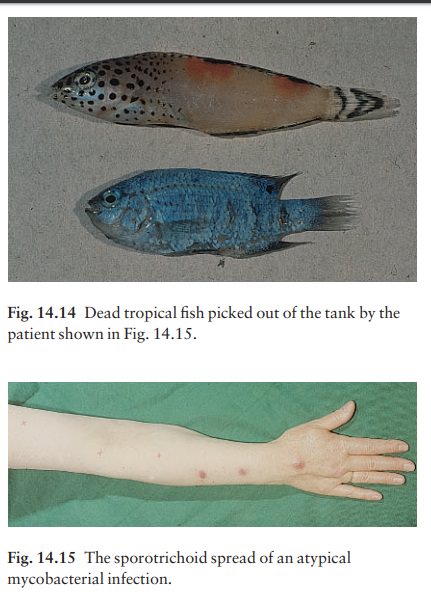Chapter: Clinical Dermatology: Infections
Deep fungal infections
Deep
fungal infections
Histoplasmosis
Histoplasma
capsulatum is found in soil and in thedroppings of some animals (e.g.
bats). Airborne spores are inhaled and cause lung lesions, which are in many
ways like those of tuberculosis. Later, granulo-matous skin lesions may appear,
particularly in the immunocompromised. Amphotericin B or itracona-zole, given
systemically, is often helpful.
Coccidioidomycosis
The
causative organism, Coccidioides immitis, is
present in the soil in arid areas in the USA. Its spores are inhaled, and the
pulmonary infection may be accompanied by a fever. At this stage erythema
nodosum may be seen. In a few patients the
infection becomes dis-seminated, with ulcers or deep abscesses in the skin.
Treatment is with amphotericin B or itraconazole.
Blastomycosis
Infections
with Blastomyces
dermatitidis are virtually confined to rural areas of the USA. Rarely,
the organ-ism is inoculated into the skin; more often it is inhaled and then
spreads systemically from the pulmonary focus to other organs including the
skin. There the lesions are wart-like, hyperkeratotic nodules, which spread
peripherally with a verrucose edge, while tend-ing to clear and scar centrally.
Treatment is with sys-temic amphotericin B or itraconazole.
Sporotrichosis
The
causative fungus, Sporotrichum schencki, lives
sap-rophytically in soil or on wood in warm humid countries.
Infection
is through a wound, where later a lesion like an indolent boil arises. Later
still, nodules appear in succession along the draining lymphatics (Fig. 14.15).
Potassium iodide or itraconazole are both effective.

Actinomycosis
The
causative organism, Actinomyces israeli, is bacte-rial
but traditionally considered with the fungi. It has long branching hyphae and
is part of the normal flora of the mouth and bowel. In actinomycosis, a lumpy
induration and scarring coexist with multiple sinuses discharging pus
containing ‘sulphur granules’, made up of tangled filaments. Favourite sites
are the jaw, and the chest and abdominal walls. Long-term peni-cillin is the
treatment of choice.
Mycetoma (Madura foot)
Various
species of fungus or actinomycetes may be involved. They gain access to the
subcutaneous tissues, usually of the feet or legs, via a penetrating wound. The
area becomes lumpy and distorted, later enlarg-ing and developing multiple
sinuses. Pus exuding from these shows tiny diagnostic granules. Surgery may be
a valuable alternative to the often poor results of medical treatment, which is
with systemic antibio-tics or antifungal drugs, depending on the organism
isolated.
Related Topics